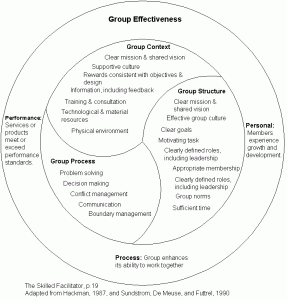p.13: Effective facilitator behavior and effective group member behavior are the same thing.
p.14: to be effective, your system of facilitation needs to be internally consistent.
p.21: In the long run, a group that does not meet its member’s needs is less effective than one that does.
p.21: if in the long run one criterion is not met, it affects the other two criteria. Groups are not, however, either effective or ineffective; their effectiveness is measured on a continuum of effectiveness.
p.23: Members of an effective group openly confront each other, believing that each person is strong enough to receive negative feedback directly.
p.25: In an effective group, members test out their assumptions and inferences to determine if they are valid, rather than simply acting as if they are true.
p.25: an effective group deals with undiscussable issues
p.25: In an effective group, members can articulate the group’s task and what they are responsible for accomplishing … they know what kind of authority and autonomy the group has.
p.27: In an effective group, members can articulate their mission and vision, find it engaging, and use it to guide their work.
p.27: In an effective group, members can articulate the group’s core values and beliefs, and they take actions and make decisions that are consistent with the shared values and beliefs.
p.29: In an effective group, members understand clearly what role each member plays and what behavior people expect in each role. (cf.: Waterline Model)
p.30: An effective group clarifies its roles as the tasks changes or as members change.
One key role is that of the leader.
In an effective group, members understand and support the leader role.
p.31: An effective group recognizes that, although it may not control the group context, it might influence the larger organization to create a more supportive context.
p.31: An effective group understands and shares the organization’s mission and vision and makes group decisions consistent with them.
p.32: An effective group asks others to explain the mission or vision rather than ignoring it or complaining within their group that others have not made it clear.
p.33: To create an effective group, the organization rewards behavior that is consistent with the group’s objectives.
p.33: An effective group has access to the valid and relevant information needed to perform the work, whether it is information about markets, staffing, production scheduling or costs, or other topics.
Similarly, an effective group has access to information about the constraints with which the members must make their own decisions and the effects that the decisions will have on other parts of the organization.

